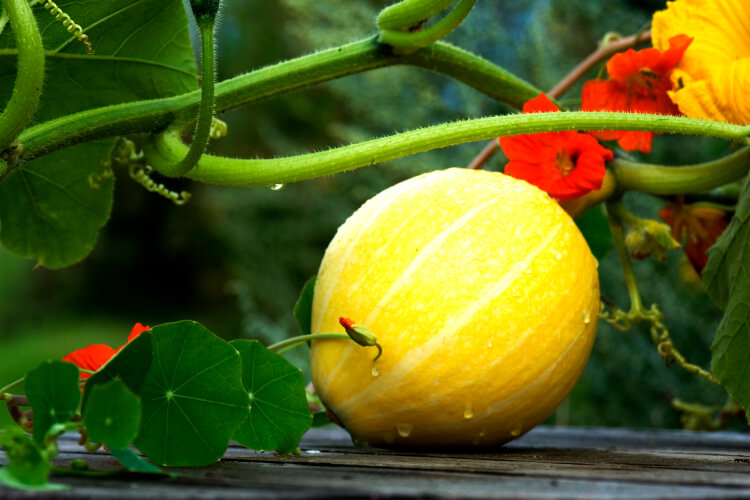I’ll make a bold statement: Everybody loves a pumpkin!
While they’re harvested in and associated with fall, pumpkins need to be seeded quite early in the season to give them time to grow into the big orange basketballs we know and love. And did you know that you can actually plant certain things close to your pumpkins to help them grow to their full potential?
Companion planting involves placing complementary plants next to each other so you get the benefits of both. This technique helps you maximize both the space and the productivity of your garden while also keeping pest problems to a minimum. Some of the best pumpkin companion plants include:
- Corn
- Pole beans
- Various flowering herbs
- Radishes
- Tomatoes
- Marigolds
- Nasturtium
- Sunflowers
- Petunias
In this article, you’ll learn more about these wonderful pumpkin neighbors and how you can plant them in your garden. You’ll also discover which plants don’t mix so well with pumpkins and the answers to some common questions.
Let’s get started!
RELATED: Not sure how many pumpkins to expect from your garden this year? Stop by our post on how many pumpkins the average plant produces to get some ideas!
Table of Contents
Best Pumpkin Companion Plants
1. Corn
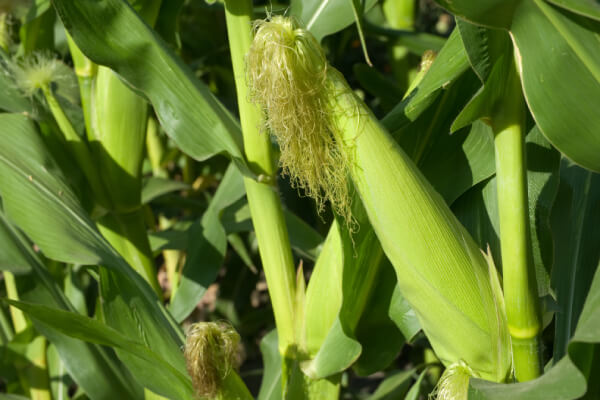
You might have already heard of the “Three Sisters.” This is a name for a companion planting triad that is traditional amongst certain Native American tribes:
- Pole beans
- Squash (most often, pumpkins)
- Corn
Corn, the tallest member of that triad, provides a trellis for the beans to climb on. Then, the sprawling pumpkin vine at its feet shades out weeds and keeps the roots cool.
The best way to plant a Three Sisters grouping is in a mound or a group of mounds about 2-3 feet apart. Sow the corn first, planting a group of seeds at the top of each mound just a few inches apart. The corn stalks need to grow close together to get the best pollination rates, since corn flowers are wind-pollinated, not insect pollinated.
Sow the squash seeds in the middle of the corn, and plant your bean seedlings when the corn is about 6 or 8 inches tall.
If you’d like to see a demonstration of planting a Three Sisters garden, check out this video from GrowOrganic Peaceful Valley:
2. Pole Beans
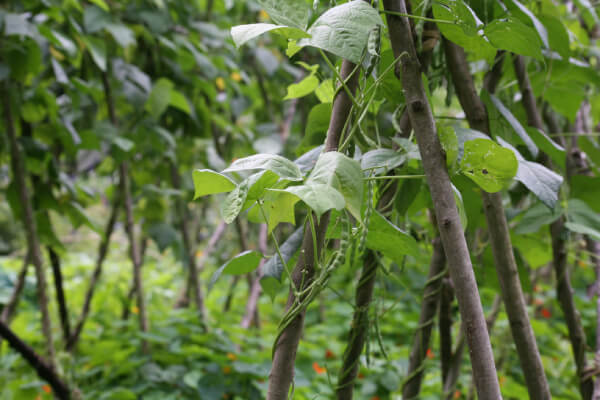
Beans, the second Sister of the three, add to the mix by fixing nitrogen. This is a term that farmers and botanists use to describe how the roots of legume plants mine nitrogen molecules from the air and convert them into a soil-bound form that other plants can access. Cool, right?
Pole beans are great to grow with corn because they will grow vertically up the corn, saving space. And they will fix nitrogen for the very nitrogen-hungry corn and pumpkin plants.
3. Borage
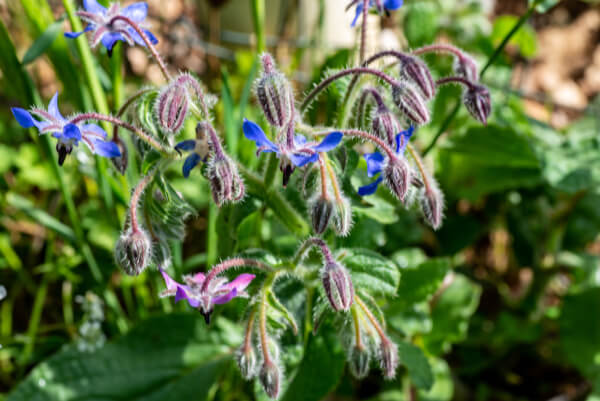
Borage is an extremely handy herb to grow in the garden:
- It’s a cut flower
- It’s edible (and tastes EXACTLY like a cucumber, we do not lie)
- It attracts pollinators to itself and nearby flowers
And since pumpkins depend on insects to pollinate their flowers for fruit development, it’s a good idea to do everything you can to increase your garden’s pollinator population.
Direct sow borage after all danger of frost has passed. Borage doesn’t appreciate having its roots disturbed, so it’s not a great choice for starting indoors and transplanting later. When the plants die back in the cold weather, incorporate the nutrient-rich leaves into your compost or winter mulch for added benefit.
4. Korean Licorice Mint
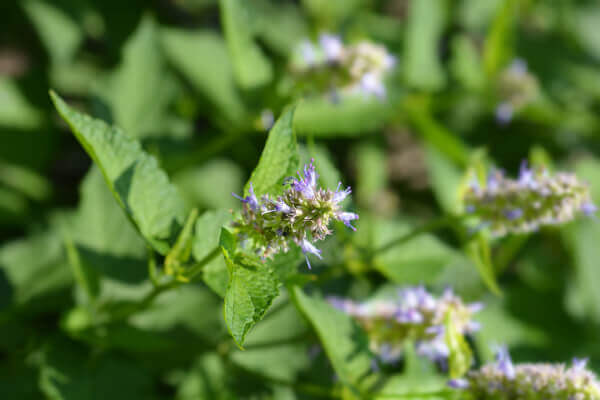
Also known as agastache and hummingbird mint, Korean licorice mint (Agastache rugosa) attracts more than just hummingbirds. Its leaves are the favored egg-laying spot for females of several hoverfly species.
While flies may not seem like beneficial insects, hoverfly larvae will happily eat bad bugs like mites, aphids, mealybugs, and other pests that target pumpkins. And, as adults, hoverflies are highly efficient and wide-ranging pollinator insects.
Agastache is also a great addition to gardens in hot climates, as it thrives in the heat. It’s also deer resistant and easy to propagate, and it’s a beautiful flower in the landscape or bouquets.
But do use some caution here. All members of the mint family are aggressive growers that can take over your garden. It might be a good idea to plant your licorice mint in a pot to contain its growth.
5. Flowering Herbs
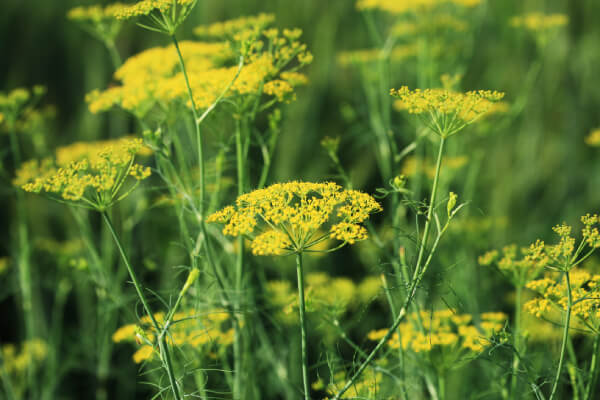
Herbs in general grow well with pumpkins, but the ones that flower are most helpful, as they do attract pollinators and other beneficial insects to the area.
If you grow herbs like thyme, sage and oregano near pumpkins, you’ll be ahead of the game later down the line when you’re ready to cook them pumpkins, as they make a great seasoning for roasted vegetables!
Other flowering herbs that grow well next to pumpkins are:
- Bee balm (Monarda)
- Dill
- Rosemary
- Pineapple sage
- Chives
- Chamomile
- Feverfew
6. Radishes
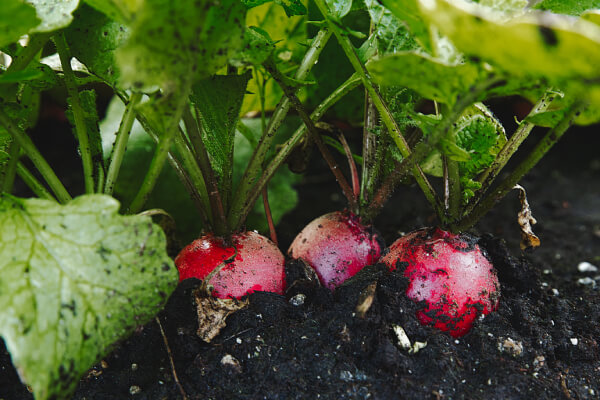
Radishes are a great companion plant for pumpkins and other vegetables because they serve as a trap crop for flea beetles.
Flea beetles will consume the leaves of pumpkins, tomatoes, spinach, kale, and other vegetables, but their favorite meal is actually radish leaves. So a group of radishes planted close to your pumpkin–but far enough away that the growing radish doesn’t disturb the roots–will be irresistible to the flea beetles, and they’ll leave your pumpkins alone.
7. Tomatoes

Can pumpkins and tomatoes be planted together? Yes! Pumpkins and tomatoes go together like… well, nothing we can think of. But as companion plants, they tend to do very well.
These two plants benefit each other much like the Three Sisters grouping does: the pumpkin sprawls across the ground and shades out weeds while the tomato grows tall.
However, because each of these plants has a widespread root system, they’ll need more space than the Three Sisters. Plant the tomato plant on the edge of the pumpkin patch for easiest harvesting, and make sure the plants are at least 2 feet apart.
Tomatoes are a warm-weather crop, and they do not tolerate the cold at all. If you want to grow your tomatoes from seed, you’ll need to start them indoors during the early to mid-spring in most regions of the U.S. If you only want a couple of tomato plants, it may be easier to buy established seedlings at a local store or garden center.
8. Lavender
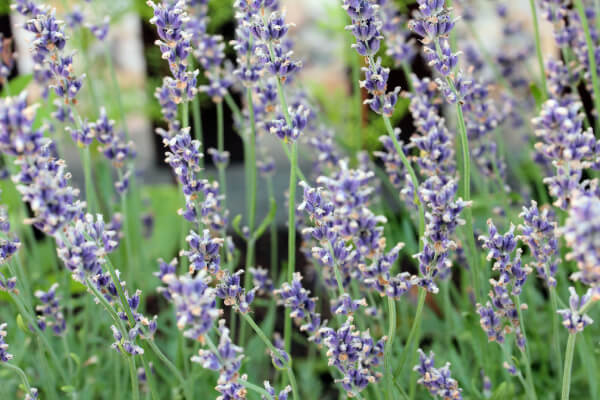
Lavender is a bee magnet and a great way to get these and other pollinators in touch with your pumpkin blossoms.
It’s also a useful crop in and of itself, with fragrant flowers that are a breeze to harvest, dry, and use throughout the home for fragrance, from your clothes drawers to your pillowcases.
9. Marigolds
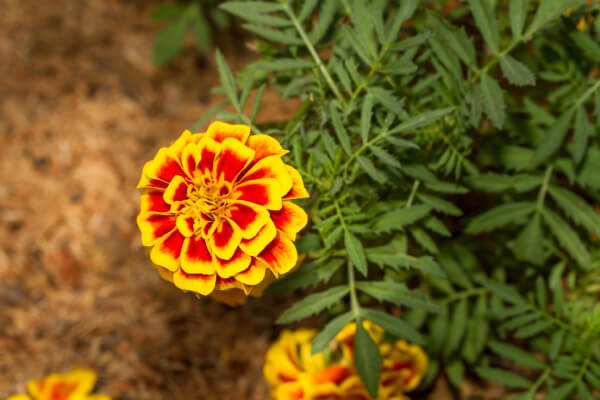
Marigolds are also very popular with bees, but they are distinctly unpopular with a certain type of garden pest.
The root-knot nematode is a pest that lives in the soil and attacks the roots of many vegetables, including pumpkins. An affected plant usually doesn’t die right away, but by mid-summer will show signs of stunted growth, slow growth, poor flowering and fruit set, and will usually die early.
According to Louisiana State University Ag Center, marigolds are effective at reducing the impact of this pest in your pumpkins and other vegetables. Root-knot nematodes are attracted to the roots of marigolds. But once they come in contact with certain substances marigold roots excrete, their life cycle is halted and they can’t develop further to lay more eggs and wreak havoc in your garden.
French Marigolds, in particular the variety ‘Tangerine,’ are most effective against this pest. One variety, ‘Signet’, displays no resistance, so choose other types of marigold.
10. Nasturtium
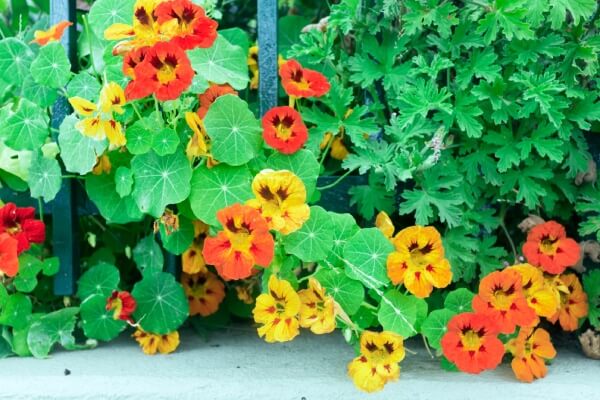
Nasturtiums are a good match for pumpkins for several reasons, but the primary one is that they actually repel squash bugs. Squash bugs are a scourge in the summer garden, and they like to eat the leaves and vines of pumpkins, other winter squash and zucchini.
Conversely, nasturtiums are also attractive to ladybugs, which feed on aphids and other soft-bodied insect pests. These orange flowers are also edible, with a peppery kick that adds zing to salads.
We also love the unique appearance of both the nasturtium flower and the round, medallion-like leaves, which bring color and texture into the garden.
RELATED: While adding companion plants are beneficial to your pumpkin’s growth potential, knowing when to plant your pumpkins is even more crucial. Find out what determines when you ought to plant your pumpkins this year!
11. Sunflowers
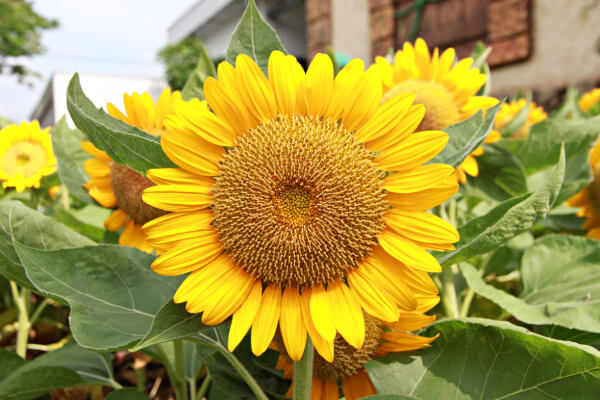
Sunflowers are an easy-to-grow companion plant for pumpkins in combination with the Three Sisters.
They benefit from the low shade provided by the pumpkin vine while providing another trellis for the pole beans to climb. Their heavy crop of seeds effectively distracts birds away from the kernels growing on the ears of corn.
Pumpkins and sunflowers are winning fall combo, and the variety of sunflower colors, bloom sizes and height is just astounding!
12. Petunia
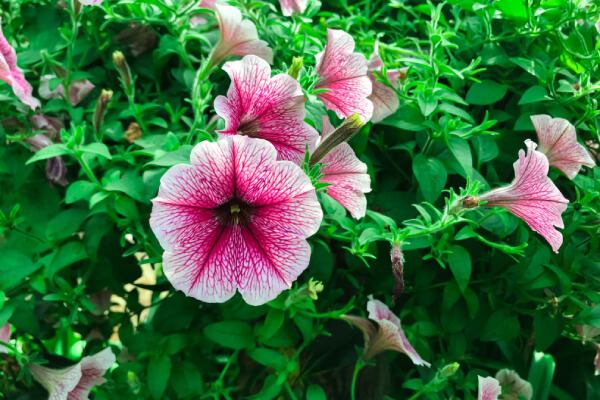
Petunias are another humble garden flower that actually has the power to repel insects that target squash (such as pumpkins), beans and tomatoes. If you like the idea of pairing tomatoes and pumpkins together in companion planting, go ahead and add petunias to the mix for even better results.
Petunias are not cold-hardy, and they typically need to be started indoors several weeks before your region’s last frost. However, petunia seedlings are available in abundance at local garden centers and many stores through spring and maybe even summer.
RELATED: If you see some leaf yellowing going on in your pumpkin patch- don’t panic. Most of the time, it’s something you can fix. Visit our post on what to do about yellow pumpkin leaves to learn more.
What Can You Not Plant with Pumpkins?
On the flip side, some plants just don’t play well with pumpkins for various reasons. Let’s take a look at what not to plant with pumpkins:
Large Root Crops
These crops have sizable underground roots, and for a good harvest you want them to become as large as possible. These tuberous roots will conflict with the widespread, fibrous root system that a pumpkin plant produces, especially around harvest time when it’s time to pull them up.
Here are some examples:
- Beets
- Turnips
- Onions
- Potatoes
- Sweet potatoes
- Rutabaga
- Carrots
For best results, plant root vegetables in groups or rows on their own instead of with pumpkins or other large vegetables.
Brassicas
Due to their high nutrient demands, brassicas don’t pair well with pumpkins. Here are some common members of the brassica family:
- Kale
- Broccoli
- Cauliflower
- Cabbage
Brassicas will outcompete pumpkins for available nutrients every time, resulting in big, lush greens and stunted, sad little pumpkins. So plant your brassicas on the opposite side of the garden from your pumpkin patch.
Cucurbits
Pumpkins belong in the cucurbit family with cucumbers, gourds, and other winter squash.
Because they’re closely related, members of this family can cross-pollinate with other members. During the first season, this isn’t an issue. But if you plan to collect seeds from your pumpkin plants, cross-pollination can give you a crop of seeds that won’t “breed true.” This means you could end up with oddly colored or misshapen pumpkins.
So if seed-saving from your pumpkin plant is on your agenda, skip the other cucurbits or keep them as far away from each other as possible.
Any Heavily Vining Plants
If you’ve ever gone to a pumpkin patch at a U-pick or corn maze, you know it looks like a real tangle. Pumpkins are aggressive viners, as are other winter squash and some summer squash.
It’s better to grow these in separate parts of the garden to avoid overcrowding. Besides being an eyesore, plants that are packed in the garden too tightly are at higher risk for disease.
What are the Benefits of Companion Planting?
Now you’ve got some great ideas of ideal plant neighbors for your pumpkins, but is companion planting really that helpful? Yes!
Companion planting is an effective gardening hack for many reasons:
- Interplanting two complementary crops saves garden space.
- Avoids pest- and disease-prone monoculture or “block planting.” When you have a grouping of a single plant type, you risk losing the entire group if one plant contracts a disease or pests. Companion planting diversifies your garden, adding a layer of protection.
- Helps deter and reduce pest problems.
- Builds natural soil enrichment (cf. Three Sisters).
- Costs nothing but boosts harvests.
- Closely-planted vegetables shade out weeds and conserve water.
Lyndsey Hyland, gardening expert and founder of Urban Organic Yield, also points out that companion planting can act as a fail-safe in case an issue arises with some of your garden crops.
“Companion planting is important to add a recovery system,” Lyndsey says. “If one plant dies, other can take its place and it’s not a total loss. This allows us to grow more plants year round in the garden, which would mean bigger and better harvests due to all the different types of vegetables that could be grown.”
Finally, companion planting is especially useful for pumpkins since their vining/climbing stems can be difficult to keep under control when they’re sprawling across the ground. This is where companion plants with sturdy stems and a tall height come in handy, functioning as a natural trellis. Corn and sunflowers are two perfect companions to help keep your pumpkin patch clean and neat.
And companion planting carries no downsides at all, so it’s a great win-win strategy all around!

Frequently Asked Questions about Pumpkin Companion Plants
Final Thoughts
Companion planting is an easy way to get a better harvest from your pumpkins and your garden in general. Conveniently, it also helps you add color and interest to your garden, increase pollinators and repel pests. What’s not to love?
Do you have any good experiences with companion plants and what grows well with pumpkins? Let us know in the comments!

